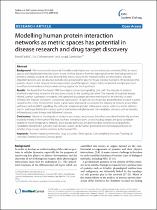| dc.description.abstract | We have recently shown by formally modelling human protein interaction networks (PINs) as metric
spaces and classified proteins into zones based on their distance from the topological centre that hub proteins are
primarily centrally located. We also showed that zones closest to the network centre are enriched for critically
important proteins and are also functionally very specialised for specific ‘house keeping’ functions. We proposed that
proteins closest to the network centre may present good therapeutic targets. Here, we present multiple pieces of
novel functional evidence that provides strong support for this hypothesis. We found that the human PINs has a highly connected signalling core, with the majority of proteins
involved in signalling located in the two zones closest to the topological centre. The majority of essential, disease
related, tumour suppressor, oncogenic and approved drug target proteins were found to be centrally located.
Similarly, the majority of proteins consistently expressed in 13 types of cancer are also predominantly located in zones
closest to the centre. Proteins from zones 1 and 2 were also found to comprise the majority of proteins in key KEGG
pathways such as MAPK-signalling, the cell cycle, apoptosis and also pathways in cancer, with very similar patterns
seen in pathways that lead to cancers such as melanoma and glioma, and non-neoplastic diseases such as measles,
inflammatory bowel disease and Alzheimer’s disease. | en_US |

